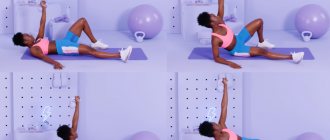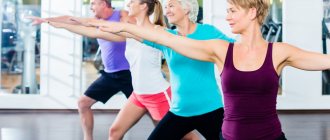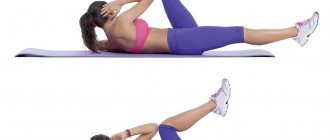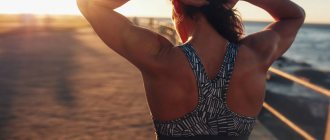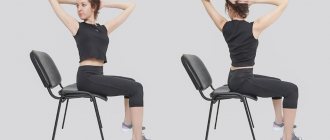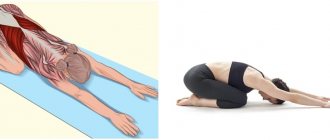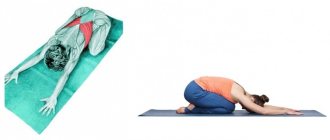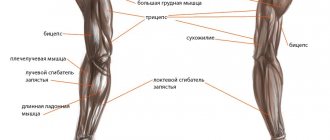Technique for performing pull-ups on the bar Errors when performing the exercise
Table of points for performing the pull-up exercise on the barPull-up training on the bar
Introduction to the exercise
Learning the exercise
Workout exercise
Technique for performing pull-ups on the bar
Hanging on the bar (in a stationary position, overhand grip, arms, body and legs straight), bending your arms, pull yourself up (chin above the bar), straightening your arms, lower yourself into a hanging position.
The hanging position is fixed for at least 1 second. (continue driving after the score is announced).
It is allowed to spread your legs to shoulder width and slightly bend your legs at the hip and knee joints.
It is forbidden to perform the exercise with a jerk or swing.
The exercise is performed using the command “TO THE PROJECTILE”.
If the exercise technique is violated, the repetition is not counted and the command “DO NOT COUNT” is given.
Organization of insurance.
Standing at the side and slightly behind the student and without touching him, hold one hand in front of the thigh, and the other one in the back near the lower back. Be prepared to hold the student if he falls off the crossbar.
Touching the student is allowed only to stop the swinging of the body.
Complex training on simulators and multi-span gymnastic equipment
Complex training is carried out with the aim of increasing the density of the lesson, improving the physical qualities and military-applied motor skills of the trainees. Its content includes previously studied program exercises, techniques and actions, as well as exercises on simulators and multi-span gymnastic apparatus.
Training is organized in a group or frontal method. In the group method, the unit is lined up in a column of three (four, etc.). The commander, having indicated the training places, gives the command: “To the training places, walk (run)
- MARCH." At this command, the squads move forward along the shortest route to the training areas, position themselves so that the indicated places are to the left of the formation, and indicate a step in place. Then, on a general command, they stop and turn left.
The commander gives the command: “GET TO THE EXERCISES.” The squad leaders go to the middle of the formation, turn to face the unit, name the exercise being performed and give the command “FREE” (“Gymnastic stance - ACCEPT”) and supervise the training of their subordinates.
To change training locations, the leader gives a command, for example, “Platoon, exercise - FINISH.” At this command, the students stop doing the exercises and line up in one line. Changing places of classes is carried out according to the commands:
“Direct-VO”, “To change places of exercise by walking (running) - MARCH.” During the first shift, the order of transition is indicated. With the frontal method, the commander determines the first training place and gives the command: “To the training place by walking (running) - MARCH.” the unit moves forward along the shortest route to the specified location, stops at the commands of the leader and turns left. After completing the exercises, the unit moves to the second training location, then to the third, etc.
It is advisable to carry out training in performing strength exercises on simulators and multi-span apparatus using the repeated method or the method of maximum effort. The number of repetitions of the exercise in one approach depends on the level of the current individual indicators of the student, which must be recorded by the commander.
Training with the repeated method consists of repeating the exercise many times with the same power (the amount of effort should be no more than 60 percent of the maximum). Training with the maximum effort method is carried out after 3-4 training sessions with the repeated method.
In training, when the practitioner performs an exercise with maximum effort, it is sometimes advisable to provide assistance in the final stage of the approach in order to overcome the psychological barrier of a certain number of repetitions. You should not stop at the achieved results.
It is always necessary to create a reserve of motor abilities, guaranteeing the necessary level of preparedness. The maximum effort method is characterized by performing exercises in such a way that the soldier shows the maximum strength of which he is currently capable.
Mistakes when performing the pull-up exercise
Exercise 17 Forward somersault
Minor - Minor bending and spreading of the legs is allowed.
Significant - Hands on the bar are at a distance greater than shoulder width. Pull-ups are performed from a hanging position with a reverse grip. Jerks and swinging movements are made with the legs. The chin touches the crossbar. Pushing off the floor and touching other objects is allowed. A sharp upward movement of the head, interceptions and opening of the palm are performed. In the starting position, the arms are bent at the elbow joints, and when moving up, the legs are bent at the knee joints. The arms are bent alternately. The exercise is interrupted by a significant rest stop.
Variants of complexes of general developmental exercises
A set of general developmental exercises on site
- 1. Starting position (i.p.) - main stance (o.s.). On the count of 1-4, rise on your toes, bend over, arms up through your sides - inhale; 5 - return to i. p. - exhale. Repeat 10-12 times.
- 2. I. p. - standing, feet shoulder-width apart, hands on the belt. Circular movements of the head, 1-4 - to the right, 5-8 - to the left. Repeat 10-12 times.
- 3. I. p. - standing, feet shoulder-width apart, arms up. Simultaneous circular movements of the arms forward. Same thing back. Breathing is uniform. Repeat 10-20 times.
- 4. I. p. - o. With. Cross movements of the arms in front of the chest, followed by a “jerk” of the arms to the sides back. Exercises can be done from and. n. leaning forward, moving your arms back more. Do not hold your breath. Repeat 10-12 times.
- 5. I. p. - feet shoulder-width apart. Alternate circular movements of the arms forward. The same - back (mill). The exercise can be performed in a tilted position, gradually increasing the tempo of movements. Breathe evenly. Repeat 15-20 times.
- 6. I. p. - o. With. Circular movements of the shoulders forward (backward), arms relaxed. Repeat 10-15 times in each direction.
- 7. I. p. - standing against the wall, arms up; sit down. 1-4 - stand on your toes, pull yourself up (as high as possible), without lifting your torso from the wall. 5-8 - imitation of sliding, etc. p. Repeat 5-6 times.
- 8. I. p. - feet shoulder-width apart, hands on the belt. 1-3 - bend forward, reach the floor with your hands - exhale; 4 - bend back, reach your heels with your hands - inhale. Do not bend your knees, bend back vigorously. Repeat 8-10 times.
- 9. I. p. - feet shoulder-width apart, hands behind the head. Turns the body left - right. The range of motion is maximum. Do not lift your feet off the floor, do not bend your legs. Repeat 10-12 times in each direction.
- 10. I. p. - feet shoulder-width apart, hands on the belt. Circular movements of the body to the right - left. Make sure you bend back enough. Repeat 10-15 times in each direction.
- 11. I. p. - feet shoulder-width apart, right hand on the belt, left hand at the top, 1-3 - springy tilts of the body to the right - inhale; 4 - i. p., left hand on the belt, right hand at the top - exhale; 5-7 - the same in the other direction; 8 - i. p. Repeat 10-15 times.
- 12. I. p. - feet shoulder-width apart, hands on the belt. Circular movements of the body to the right and then to the left. Perform the exercise with maximum amplitude. Make sure that the head and shoulders do not change their original position. Repeat 15-20 times.
- 13. I. p. - lying position. Flexion and extension of the arms in support. Repeat 5-10 times, increasing the number of repetitions from session to session.
A set of general developmental exercises in motion
- 1. I. p. - hands below. On the count of 1 and 3, hands to the shoulders, 2 - hands up, 4 - hands down. Repeat 10-12 times. Gradually increasing the pace of movement.
- 2. I. p. - hands behind the head, elbows to the sides. On the count of 1 and 3, tilt your head forward, bring your elbows together in front of you, exhale, 2 and 4 - return to i. n. - inhale. Repeat 10-12 times.
- 3. I. p. - right hand at the top, left hand at the bottom. For each count, perform jerks with your arms, changing the position of your arms. Perform hand jerks with maximum amplitude. Repeat 10-12 times.
- 4. I. p. - arms straight at the top. 1-4 - circular rotations with arms forward, 5-8 - circular rotations with arms backwards. Do not bend your arms straight at the elbows. Repeat 10-12 times.
- 5. I. p. - arms straight in front of the chest. On 3 counts - cross movements with straight arms, on 4 - clap your hands behind your back. Gradually increase the pace of movement. Repeat 10-12 times.
- 6. I. p. - hands to shoulders. On 1-4 - circular rotations with your arms forward, 5-8 - circular rotations with your arms backwards. Repeat 10-12 times.
- 7. I. p. - hands to shoulders. On 1-4 - alternate circular rotations with your arms forward, 5-8 - alternate circular rotations with your arms backwards. Breathing is uniform, the pace of the exercise is slow. Repeat 10-12 times.
- 8. I. p. - arms bent at the elbows in front of the chest. For each step, turn your torso towards the leg in front. The range of motion is maximum. Repeat 10-12 times.
- 9. I. p. - hands on the belt. 1 — torso tilt forward, 2 — torso tilt back, 3 — torso tilt to the right, 4 — torso tilt to the left. Do not bend your knees, bend back vigorously. Repeat 10-12 times.
- 10. I. p. - hands on the belt. For each count, alternately pull the right and left knees to the chest. Repeat 10-12 times.
- 11. I. p. - hands on the belt. On 1-2 - lunge forward with the right leg, springy swaying, 3-4 - lunge forward with the left leg, springy swaying. Repeat 10-12 times.
- 12. I. p. - arms straight in front of the chest. On 1 - swing your right leg forward, clap under the knee, 2 - and. p., on 3 - swing your left leg forward, clap under the knee, 4 - and. p. Perform the swing as high as possible. Repeat 10-12 times.
- 13. I. p. - hands behind the head, elbows to the sides. Hal - touching the right knee with the elbow of the right hand, 2 - and. p., on 3 - touching the left knee with the left elbow, 4 - i. p. Bend to the sides as deeply as possible. Repeat 10-12 times.
- 14. I. p. - standing still. Raise your arms - take a deep breath, lower them and bend forward - exhale (6-8 times).
A set of general developmental exercises in pairs
- 1. I. p. - standing facing each other, partners tilt their torsos forward, hands are on the partner’s shoulders. Perform deep, springy swings forward. Repeat 10-12 times.
- 2. I. p. - standing with your back to each other, legs apart, arms straight at the top intertwined with your partner’s fingers. Bend your torso to the sides without breaking your arms. Repeat 10-12 times.
- 3. I. p. - standing with your back to each other, arms straightened and raised up. On the count of 1 - lunge forward with your right leg, bend at the waist, 2 - return to i. p., on 3 - lunge forward with your left leg, bend at the waist, 4 - return to i. p. Repeat 10-12 times.
- 4. I. p. - right hands forward, left ones bent, grip with fingers. Perform alternate bending and extension of the arms with resistance from a partner. Repeat 10-12 times.
- 5. I. p. - standing facing each other, holding hands. Perform synchronized squats. The pace is average. Repeat 10-12 times.
- 6. I. p. - standing with your back to each other, straight arms to the sides. Perform torso turns to the right and left without lifting your feet from the ground. The range of motion is maximum. Repeat 10-12 times.
- 7. I. p. - standing facing each other, wide stance, legs apart. On count 1 - lunge to the right, 2 - return to i. p., on 3 - lunge to the left, 4 - return to i. p. Repeat 10-12 times.
- 8. I. p. - standing with your back to each other, arms straight at the top, holding each other’s hands. Alternate bending of the torso forward with a partner on the back. Repeat 10-12 times.
- 9. I. p. - standing with your back to each other, arms down. Swing your right leg upwards, then your left leg. Repeat 10-12 times.
- 10. I. p. - standing facing each other, raise your straight arms up and grab your partner’s hands. Perform body turns to the left - to the right without separating your arms. Repeat 10-12 times.
- 11. I. p. - standing with your back to each other, wide stance, legs apart, holding hands. On a count of 1, simultaneously bend your torso forward, and on a count of 2, return to i. p. Repeat 10-12 times.
- 12. I. p. - standing facing each other, the right leg is pressed to the partner’s thigh. Perform 10-12 jumps on the right leg, then on the left.
A set of general developmental exercises with a skipping rope
- 1. I. p. - standing, feet shoulder-width apart, hands with a rope folded in half, lowered on the shoulders. On the count of 1 - tilt the head forward, 2 - tilt the head back, 3 - tilt the head to the right, 4 - tilt the head to the left. Repeat 10-12 times.
- 2. I. p. - standing, feet shoulder-width apart, hands with a rope folded in half, lowered down. On the count of 1 - arms forward, 2 - arms up, rise on your toes, 3 - arms forward, 4 - i. p. Repeat 10-12 times.
- 3. I. p. - standing, feet shoulder-width apart, hands with a rope folded in half, lowered down. On the count of 1, raise your hands up,
- 2 - put the rope on your shoulders, 3 - raise your arms up, 4 - and. p. Repeat 10-12 times.
- 4. I. p. - standing, feet shoulder-width apart, hands with a rope folded in half, lowered on the shoulders. On the count of 1-3, tilt the torso forward, 4 - return to i. p. Repeat 10-12 times.
- 5. I. p. - standing, feet shoulder-width apart, arms with a rope folded in half, raised above the head. On the count of 1 - tilt the body to the right, 2 - and. n., 3 - tilt of the body to the left, 4 - i. p. Repeat 10-12 times.
- 6. I. p. - standing, feet shoulder-width apart, arms straight with a rope folded in half, raised forward. On the count of 1 - turn the body to the right, 2 - and. p., 3 - turn the body to the left, 4 - i. p. Repeat 10-12 times.
- 7. I. p. - standing, feet shoulder-width apart, arms with a rope folded in half, raised above the head. On the count of 1-4 - circular movements in the hip joint to the right, on 5-8 - to the left. Repeat 10-12 times.
- 8. I. p. - standing, feet shoulder-width apart, arms with a rope folded in half, raised above the head. On the count of 1 - tilt the torso forward touching the floor with the rope, 2 - squat, 3 - bend the torso forward touching the floor with the rope, 4 - i. p. Repeat 10-12 times.
- 9. I. p. - standing, feet shoulder-width apart, torso tilted forward, hands with a rope folded in half, lowered on the shoulders. On 1 - turn the body to the right, 2 - and. p., 3 - turn the body to the left, 4 - i. p. Repeat 10-12 times.
- 10. I. p. - standing, feet shoulder-width apart, arms with a rope folded in half, raised above the head. On count 1 - lunge to the right, 2 - and. p., 3 - lunge to the left, 4 - i. p. Repeat 10-12 times.
- 11. I. p. - standing, feet shoulder-width apart, hands with a rope folded in half, lowered down. On the count of 1 and 3, step over the rope, 2 and 4 - return to i. p. Repeat 10-12 times.
- 12. I. p. - standing, feet shoulder-width apart, arms straight with a rope folded in half, raised forward. Perform 10-12 squats without lifting your feet off the floor.
A set of general developmental exercises with a gymnastic stick
- 1. I. p. - standing, feet shoulder-width apart, arms with a gymnastic stick lowered down. On the count of 1, raise your hands with the stick up and rise onto your toes, 2 - return to i. p. Repeat 10-12 times.
- 2. I. p. - standing, feet shoulder-width apart, arms with a gymnastic stick lowered down. On the count of 1 - hands forward, 2 - hands up on your toes, 3 - hands forward, 4 - and. p. Repeat 10-12 times.
- 3. I. p. - standing, feet shoulder-width apart, hands with a gymnastic stick lowered behind the back at hip level. On the count of 1 and 3, raise the stick up from behind, 2 and 4 - and. p. Repeat 10-12 times.
- 4. I. p. - standing, feet shoulder-width apart, arms with a gymnastic stick lowered down. On the count of 1-3 - bend the body forward with the stick touching the floor, 4 - return to i. p. Repeat 10-12 times.
- 5. I. p. - standing, feet shoulder-width apart, hands with a gymnastic stick lowered on the shoulders. On the count of 1-2 - turn the body to the right, 3-4 - to the left. Repeat 10-12 times.
- 6. I. p. - standing, feet shoulder-width apart, arms with a gymnastic stick raised up. On the count of 1-2 - tilt the body to the right, 3-4 - to the left. Repeat 10-12 times.
- 7. I. p. - standing, feet shoulder-width apart, arms with a gymnastic stick raised forward. Holding the center of the stick with both hands, turn the stick left and right. Repeat 10-12 times.
- 8. I. p. - standing, feet shoulder-width apart, hands with a gymnastic stick lowered on the shoulders. On the count of 1-4 - circular movements in the hip joint to the right, 5-8 - to the left. Repeat 10-12 times.
- 9. I. p. - standing, feet shoulder-width apart, hands with a gymnastic stick lowered on the shoulders. On count 1 - lunge to the right, 2 - and. p., 3 - lunge to the left, 4 - i. p. Repeat 10-12 times.
- 10. I. p. - standing, feet shoulder-width apart, arms straight at the top with a gymnastic stick. On the count of 1 - perform a circular movement with the stick touching the floor, 2 - and return to i. p. Repeat 10-12 times.
- 11. I. p. - standing, feet shoulder-width apart, arms with a gymnastic stick lowered down. On counts 1 and 3, step over the stick, 2 and 4 - return to i. p. Repeat 10-12 times.
- 12. I. p. - standing, feet shoulder-width apart, arms with a gymnastic stick raised forward. Perform 10-12 squats, keeping your feet on the floor.
Table of points for performing the pull-up exercise on the bar
| Points | Col. once | Points | Col. once | Points | Col. once | Points | Col. once | Points | Col. once | Points | Col. once |
| 100 | 30 | 90 | 25 | 80 | 20 | 70 | 15 | 50 | 10 | 30 | 5 |
| 98 | 29 | 88 | 24 | 78 | 19 | 66 | 14 | 46 | 9 | 26 | 4 |
| 96 | 28 | 86 | 23 | 76 | 18 | 62 | 13 | 42 | 8 | 22 | 3 |
| 94 | 27 | 84 | 22 | 74 | 17 | 58 | 12 | 38 | 7 | 16 | 2 |
| 92 | 26 | 82 | 21 | 72 | 16 | 54 | 11 | 34 | 6 | 6 | 1 |
Note: The standards presented in the table correspond to sportswear: 1C (swimming trunks, shorts, T-shirt, sports shoes). In this form, by decision of the commander (chief) of a military unit (military educational institution), under appropriate conditions, it is allowed to practice without a T-shirt and shoes; 2C (in shorts, T-shirt, sports shoes); 3C (in a sports (training) suit, sports shoes); 4C (in an insulated sports (training) suit, insulated sports shoes, a sports hat).
Action plan: to increase the number of pull-ups on the horizontal bar
So, let's summarize. Here's a general plan of action designed to help you achieve your first pull-up, then 10-12 reps per set, first weighted pull-up, and so on, in the fastest way possible:
Step 1: How to Achieve 10-12 Pull-Ups Per Set (twice a week)
- Scapular pull-ups: 3 sets of 10-12 reps;
- Banded pull-ups: 3 sets of 6-12 reps;
- Kneeling lat pulldown: 3 sets of 10-15 reps;
- Reverse rows: 3 sets of 8-12 reps (minimum body angle to the floor);
- Negative pull-ups: 2-3 sets of 30 seconds.
Perform two sets of max-rep pull-ups before this workout, as well as 1-2 weight training sessions throughout the week.
Step 2: Improve the result
- Perform weighted pull-ups twice a week (devote one day to other pull-up variations) for 3-4 sets of 6-10 reps.
- Start with a weight of 1-2.5 kg, and add 1-2.5 kg as you are able to perform 3-4 sets of 10 repetitions.
- After 4 weeks of hard training, take a week off or do a week of training with minimal impact.
I hope you will see that with the right approach you can achieve significant results. And this step-by-step program, which builds protocol and exercise into your weekly plan, shows you how to properly progress over time. So you can break through the ceiling and achieve results in the most effective way, just like countless other participants who have successfully completed the program.

